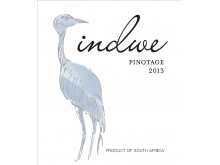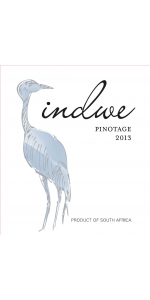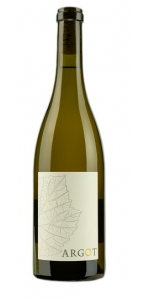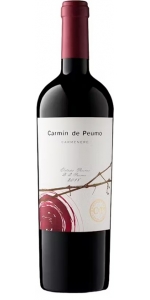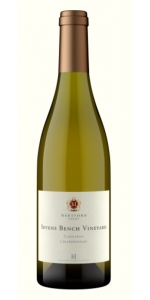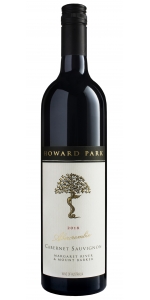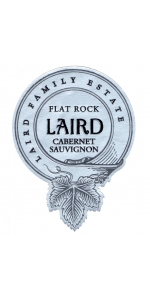Indwe Pinotage Coastal Region 2018
| Country: | South Africa |
| Region: | Elim |
| Winery: | Indwe |
| Grape Type: | Pinotage |
| Organic: | Yes |
| Vintage: | 2018 |
| Bottle Size: | 750 ml |
Indwe Pinotage Coastal Region is made from 100 percent Pinotage.
Pinotage is a true South African grape variety, Our signature grape smilar to the Blue Crane being our national bird. Indwe Pinotage grapes are meticulously sourced from our grape producers along the Coastal region of the Western Cape ensuring complexity, depth and purity of fruit. The wine is layered with sweet cherry notes, and subtle hints of mocha and vanilla flavors.
Argot Chardonnay Sonoma County is made from 100 percent Chardonnay.
Pouring a green-tinted gold, our Sonoma County Chardonnay is a beautiful wine from word go. Radiating from within, a blast of apple/pear fruit informs this wine both aromatically, and on the palate. As flavors unfurl, a progression of orange blossom, pineapple, white peach, and hazlenut are followed by a finish dominated by ginger, baked apple, with a trailing kiss of mint’s freshness. A stunning wine — wholly informed by the perfection of 2018’s growing season — defined by its dichotomy of massively intense flavors, and superb acidity and freshness.
Raised by minimalistic methods, often associated with the classic Chardonnay winemaking techniques of Meursault. With a focus on the coolest Chardonnay region in Sonoma County, 2018’s long, even growing season favored our vineyards’ moderate climate, old vines and deep volcanic soils. These grapes were allowed an extended ripening period on the vine, resulting in perfect balance and concentrated flavors.
The Peumo Vineyard is located 170 m above sea level and extended along the Cachapoal River, on terraces of hills of the Coastal Mountains. The vines come from pre-phylloxera cuttings and are trellised to vertical shoot position and cordon pruned. The soils are deep with an upper layer of clay that retains moisture, which controls the vines’ vigor and growth and allows them to remain active through late May, when the Carmenere is picked.
Deep, dark red with hints of violet. Elegant and mineral on the nose, with notes of blackberry and a touch of blackcurrant. It fills the palate with underlying mature tannins. Deep, concentrated, with a long aftertaste and distinctive hints of the Peumo terroir. This 2018 vintage is characterized by its elegance and freshness; it is a wine with a lot of Carmenere character. Pairs best with elegant but simply prepared dishes such as juicy, rare roast beef, veal, pork tenderloin with roasted beets and cranberries, duck (con t or magret). Also delightful with squash-stuffed pasta with morel mushrooms or aged goat cheese with figs.
Review:
Carmín made its debut with the 2003 vintage, and since then it has come from a selection from Block 32, a sector of the vineyard in Peumo, on the banks of the Rapel River. Of its 28 hectares, seven are actually used and usually produce about 18,000 liters. The vineyards were planted in 1983 on stony clay soils on the hills that flank the Cachapoal River on its way to Lake Rapel. This was a cool year, and that's evident in the herbal notes and red fruits that fill the nose. The palate is generous in ripe red fruits, as well as in the herbal tones that refresh and add complexity at the same time. The texture is friendly, although it leaves room for a layer of very fine, sharp tannins that contribute tension, while the fruits and herbs continue their private party. We think this is the best version of Carmín that we have tried—far from the first Carmíns, which were tremendously ripe and extracted and far from this balance and elegance. Carmenere at the highest level.
-Patricio Tapia - Descorchados 98 Points
Hartford Court Sevens Bench Vineyard Chardonnay is made from 100 percent Chardonnay.
True to its Carneros roots, the 2018 Sevens Bench Chardonnay carries the hallmark of the region – fruit intensity balanced by and good acidity. The aromas are driven by classic lemon drop, Meyer lemon, and lemongrass. That fruit style follows in the flavors, with the citrus focus carrying through with candied lemon drop balanced by the mineral and flint characters inherent to the region and the clonal selections. Barrel fermentation notes in the background add even more complexity to this elegant wine.
Review:
I always seem to find a tropical slant in Chardonnay from Carneros, and the 2018 Chardonnay Sevens Bench Vineyard has it in spades, with ample pineapple, honeyed peach, pear, and toasted spice-like aromas and flavors. This is another balanced, rich, medium to full-bodied Chardonnay from this estate that's loaded with character. Drink it over the coming 5-7 years
-Jeb Dunnuck 95 Points
Howard Park Abercrombie Cabernet Sauvignon 100% Cabernet Sauvignon.
The 2018 Abercrombie reflects the highs that can be achieved in a superb vintage when thoughtful and deliberate winemaking combine with exceptional vineyards. The color is a vivid, deep ruby, tingeing purple and betraying the wine's youth. The bouquet evolves in a measured fashion as the wine slowly aerates, filling the glass with textbook Cabernet perfume of powerful dark fruits, rubbed bay leaf, cedar, coffee beans and vanilla. Intensity and purity of fruit is the standout feature, and this transmits seamlessly to the palate, where the profound structure and effortless length also take centre stage. The harmony of rich fruit, clean and vibrant acidity and fine, abiding tannins speak to the beguiling nature of this young wine and the glorious future that awaits its patient custodians in ensuing decades. This is true West Australian Cabernet.
Named for Walter Abercrombie, the much loved Great Grandfather and mentor of Jeff Burch, the owner of Howard Park Wines, this is Howard Park's finest Cabernet Sauvignon.
Howard Park’s winemaking philosophy is to craft elegant, age-worthy wines from our best sites in the Margaret River & Great Southern regions of Western Australia. Critical site selection, meticulous viticultural practice and detailed winemaking underline each Icon wine.
Review:
This is really fine with such polished and manicured fruit and tannins that deliver a thoroughly refined and beautiful palate with sweet dark fruit, from currants to blackberries. Long, long finish. Hard not to drink now. But one for the cellar. Try after 2025.
-James Suckling 97 Points
Laird Cabernet Sauvignon Flat Rock Ranch is made from 100 percent Cabernet Sauvignon.
Laird's Flat Rock Ranch vineyard is located near the north corner of where Yountville Cross Road meets Silverado Trail, on State Lane. This prized, complex fruit from the Yountville Appellation is a result of unique geological and meteorological conditions: volcanic soils similar to the adjacent Stags Leap District, but also display ancient coastal deposits, and sedimentary and alluvial soils that provide beneficial stress for our vines. Marine air currents from San Pablo Bay to the south are caught when they reach the "Yountville Mounts," providing a natural cooling effect that balances warm, sunny days that ripen the rich tannins of our hallmark Cabernet Sauvignon to elegant distinction.
Bold violet-red color introduces a captivating bouquet of blueberries, tea leaf, and vanilla. This full-bodied wine has flavors of cassis, hazelnut and briary undertones with fresh acidity and chewy tannins on the palate
Review:
"The 2018 Cabernet Sauvignon Flat Rock is laced with crème de cassis, menthol, lavender, spice and blueberry jam. Inky and plush, the 2018 also has quite a bit of energy backing it all up. The 2018 is a gorgeous wine from Laird.- Antonio GALLONI"
- Vinous (The 2019 Napa Valley Cabernets: A Deep Dive, January 2022), 93+ pts
Indwe Pinotage Coastal Region is made from 100 percent Pinotage.
Pinotage is a true South African grape variety, Our signature grape smilar to the Blue Crane being our national bird. Indwe Pinotage grapes are meticulously sourced from our grape producers along the Coastal region of the Western Cape ensuring complexity, depth and purity of fruit. The wine is layered with sweet cherry notes, and subtle hints of mocha and vanilla flavors.
The Indwe Estate
At the southern-most tip of Africa, where the Atlantic and Indian Oceans meet, one finds the ‘Cape of Storms’, or more commonly, Cape Agulhas. On this peninsula lies the Elim ward and Overberg region, where we source the grapes for Indwe Sauvignon Blanc. Indwe is the Xhosa name for the Blue Crane, South Africa’s national bird. It is an endangered species and endemic to South Africa, particularly the Overberg region. The Blue Crane is very special to the amaXhosa and amaZulu, often associated with warriors and royalty.
Owner and Winemaker is Trizanne Barnard. During her productive vinous career, she has seized every possible opportunity to broaden her knowledge and experience, pressing them for every drop of goodness they offered, enriching her life, her work and her wine. With a B.Sc Agric under her belt she stepped into the real world of wine, completing harvests in Western Australia, Alsace, Bordeaux, Rhone and Douro Valley.
Back on home soil, after a year at Klein Constantia she was challenged with setting up a winery in the Helderberg. After four successful years,she decided it was time to venture on my own, creating her own project.
The Indwe Estate
At the southern-most tip of Africa, where the Atlantic and Indian Oceans meet, one finds the ‘Cape of Storms’, or more commonly, Cape Agulhas. On this peninsula lies the Elim ward and Overberg region, where we source the grapes for Indwe Sauvignon Blanc. Indwe is the Xhosa name for the Blue Crane, South Africa’s national bird. It is an endangered species and endemic to South Africa, particularly the Overberg region. The Blue Crane is very special to the amaXhosa and amaZulu, often associated with warriors and royalty.
Owner and Winemaker is Trizanne Barnard. During her productive vinous career, she has seized every possible opportunity to broaden her knowledge and experience, pressing them for every drop of goodness they offered, enriching her life, her work and her wine. With a B.Sc Agric under her belt she stepped into the real world of wine, completing harvests in Western Australia, Alsace, Bordeaux, Rhone and Douro Valley.
Back on home soil, after a year at Klein Constantia she was challenged with setting up a winery in the Helderberg. After four successful years,she decided it was time to venture on my own, creating her own project.
The Vineyards
The historic mission settlement of Elim on the Agulhas Plain comprises 6 500 hectares of land.  Half of this land is under agriculture and for the past one hundred years has been cultivated and the remaining + 3 000 hectares of Elim ferricrete fynbos is managed by the Moravian Church and the community at the Elim mission station.
Elim was established in 1824 by Moravian missionaries and sacramental wine was required for church services, and the first vineyard planting in this region subsequently occurred over 100 years ago however viticulture didn’t really establish until 1997 when it resumed again.
First Vineyard plantings: 1996 – Lands End. After Lands End, The Berrio planted the next vineyards in 1997.
Producers in Elim:
- The Berrio: 33.7 hectares (planted with 80% of white grape varietals)
- Black Oystercatcher: 18 hectares (planted with 68% of white grape varietals)
- First Sighting: 70 hectares (planted with 55% of white grape varietals)
- Zoetendal: 7.46 hectares (planted with 85% of white grape varietals)
Total hectares of vineyards 129.16 Ha = 319.161 Acres
White grape varietals found on Elim: approximately 80% Sauvignon Blanc, 15% Semillon and the rest is small parcels of Viognier, Nouvelle.
- back
The Grade Cabernet Sauvignon Serpent's Back Napa Valley is made from 100 percent Cabernet Sauvignon.
Review:
The 2019 Cabernet Sauvignon Serpent's Back shows a more aromatic, high-toned side of this site. Bright red/purplish berry fruit, pomegranate, cinnamon and sweet floral accents are all laced together. The Serpent's Back is the most refined of these three Cabernets, but it has plenty of Calistoga punch.
-- Antonio Galloni 95 Points
Holocene Memorialis Pinot Noir is made from 100 percent Pinot Noir.
Holocene Pinot Noir Memorialis is a blend of 777, Pommard and 115 clones from MonksGate vineyard in the Yamhill-Carlton AVA, and it saw about 20% new French oak for 16 months prior to bottling. It is always the lighter and more feminine of the two Holocene wines, with red fruits, white flowers, dried herbs, mushroom and forest floor aromatics, bright acidity and a lithe texture, long finish.
By now, everyone knows that the Willamette Valley is an amazing place to grow Pinot Noir. When I relocated from Napa Valley to partner up with Force Majeure Vineyards, I knew I also wanted to start a project where I could focus attention on a varietal and growing region that I loved. Part of the excitement of being in the Pacific Northwest is the ability to have access to so many amazing vineyards and so much diversity, along with the opportunity to push boundaries and try new things – something that is becoming increasingly difficult in other growing regions.
We partner up with a few very small, diverse and amazing vineyards in the Willamette Valley, sourcing fruit from these dry-farmed sites that emphasize low yields, sustainable practices and produce outstanding fruit.
The wines are crafted in the same way I have been making wine since I was carrying it out at Bryant Family Vineyard in the Napa Valley — utilizing very low-impact, non-industrial techniques, native yeasts, little extraction and little new oak, and never filtering or fining. This allows a real sense of place to show through in the wines that is often dimmed when too much manipulation is undertaken.
Our first vintage was 2015, and was released in early 2017. As production is currently extremely small, the best way to get the wines into your hands is to join our mailing list at the “Mailing List” link above to receive an allocation when we have a release. We release wines once per year, and they will be sold on a first come, first served basis, shipped straight to your door.
Review:
"A Bing cherry aroma slinks its way up from the glass, followed by spicy whispers of cardamom and cinnamon. Straw and chalkboard dust scents seal the deal. After a tannic black tea note materializes on the palate, the wine's cranberry and raspberry flavors punch the tart button. You can feel the tannins, but they aren't grippy. The acidity, however, lets you know it is ready for juicy business. Memorialis is quietly becoming one of Oregon's best Pinot Noirs. — Michael ALBERTYS"
- - Wine Enthusiast (October 1st 2025), 98 pts & Editor's Choice

